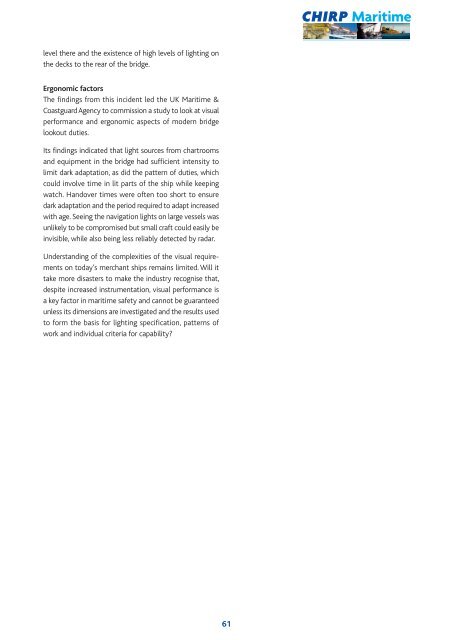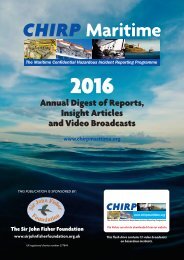CHIRP annual digest 2016 6th
You also want an ePaper? Increase the reach of your titles
YUMPU automatically turns print PDFs into web optimized ePapers that Google loves.
<strong>CHIRP</strong> Maritime<br />
level there and the existence of high levels of lighting on<br />
the decks to the rear of the bridge.<br />
Ergonomic factors<br />
The findings from this incident led the UK Maritime &<br />
Coastguard Agency to commission a study to look at visual<br />
performance and ergonomic aspects of modern bridge<br />
lookout duties.<br />
Its findings indicated that light sources from chartrooms<br />
and equipment in the bridge had sufficient intensity to<br />
limit dark adaptation, as did the pattern of duties, which<br />
could involve time in lit parts of the ship while keeping<br />
watch. Handover times were often too short to ensure<br />
dark adaptation and the period required to adapt increased<br />
with age. Seeing the navigation lights on large vessels was<br />
unlikely to be compromised but small craft could easily be<br />
invisible, while also being less reliably detected by radar.<br />
Understanding of the complexities of the visual require -<br />
ments on today’s merchant ships remains limited. Will it<br />
take more disasters to make the industry recognise that,<br />
despite increased instrumentation, visual performance is<br />
a key factor in maritime safety and cannot be guaranteed<br />
unless its dimensions are investigated and the results used<br />
to form the basis for lighting specification, patterns of<br />
work and individual criteria for capability?<br />
61



